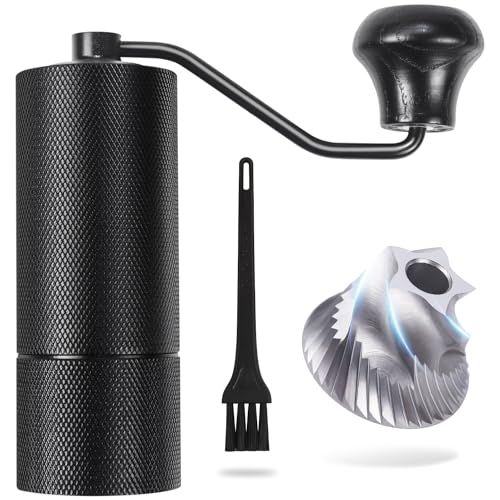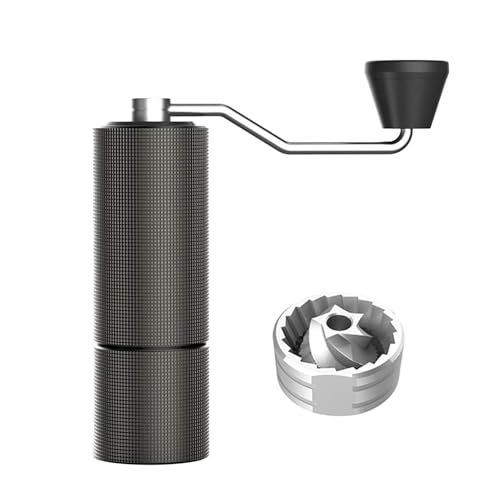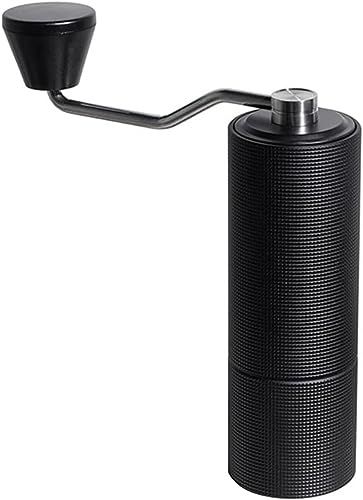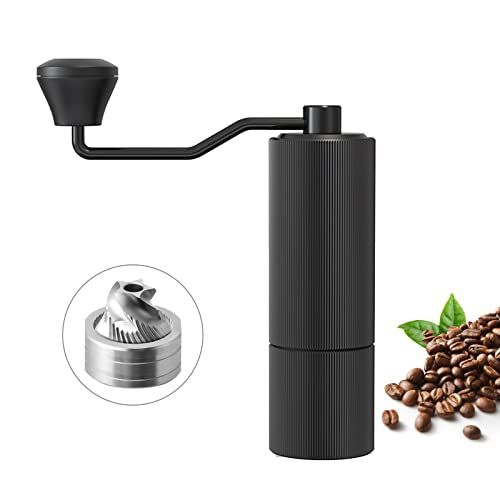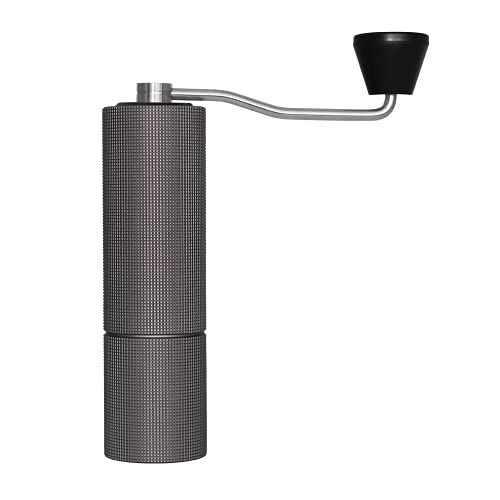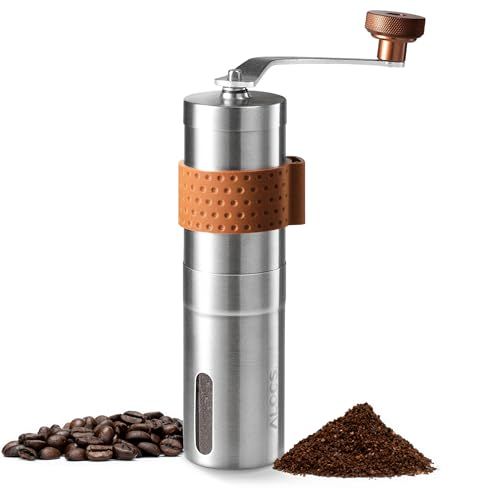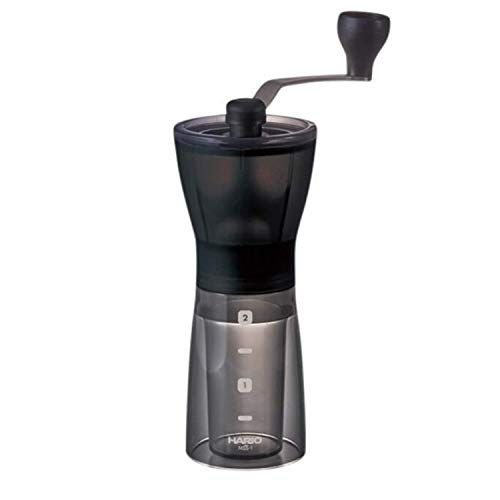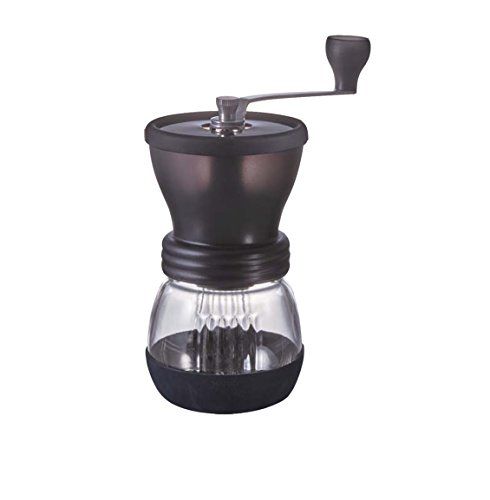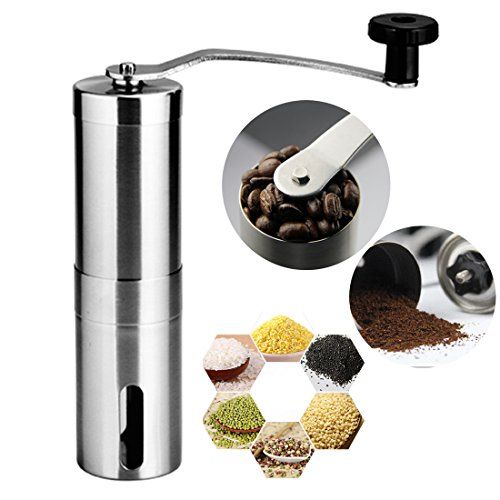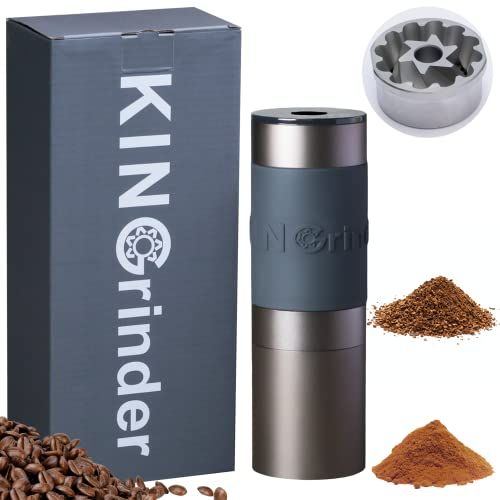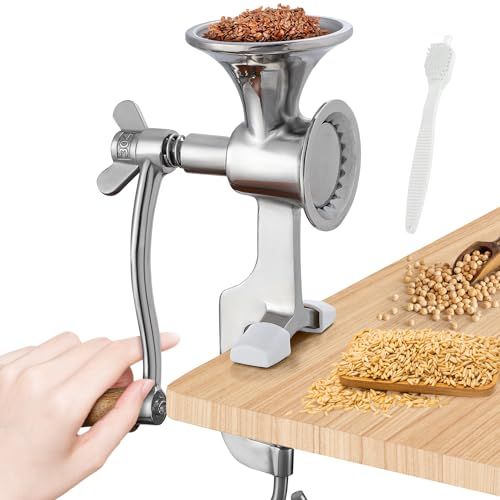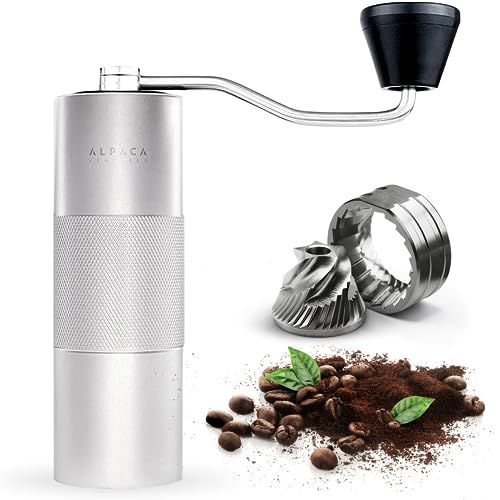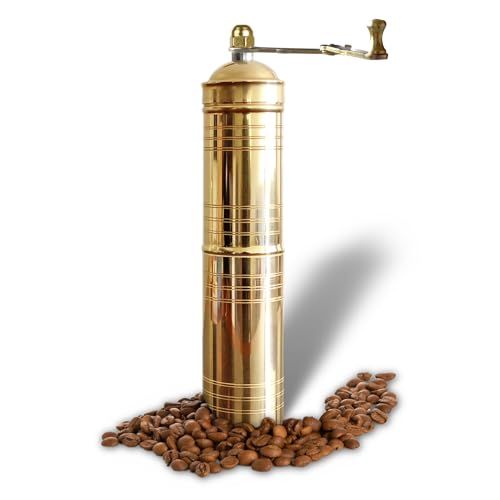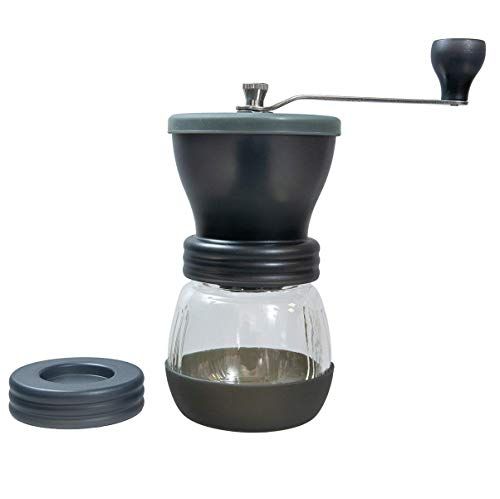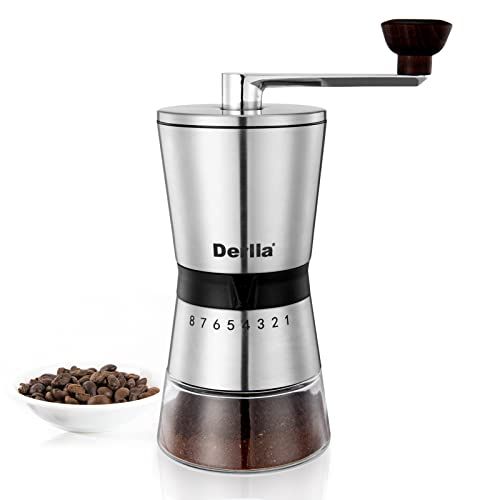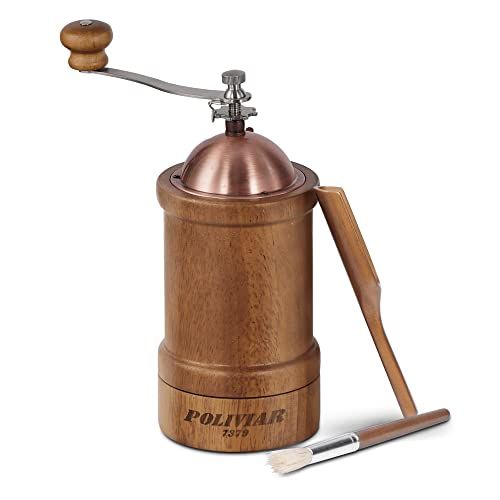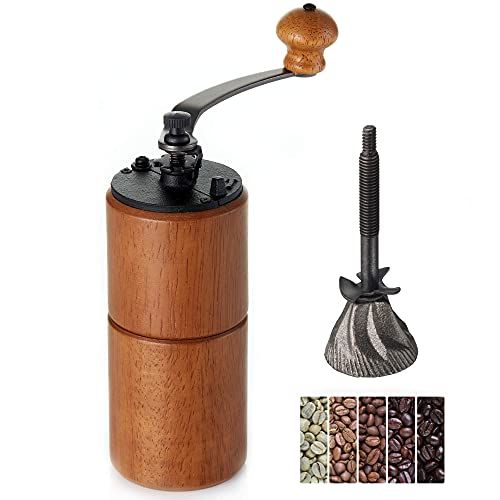Categories
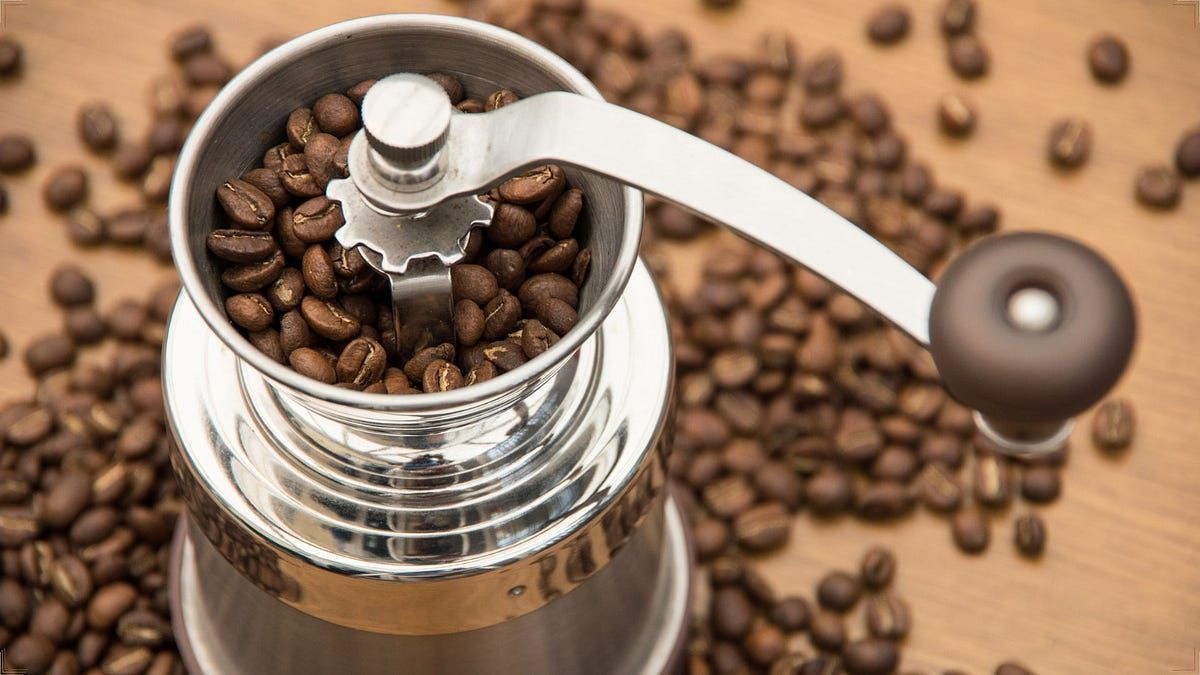
Manual coffee grinders provide a simple, hands-on method for achieving a consistent grind for brewing delicious coffee. Compared to electric grinders, they give the user more control over grind size, allow grinding small batches by hand, and are quiet, portable, and easy to clean. Manual grinders are a great option for anyone looking to maximize flavor and customize their coffee grinding routine.
The main benefits of using a manual coffee grinder include:
More consistency - The grind can be fine-tuned more precisely. This allows the grounds to extract optimally during brewing.
Lower cost - Quality manual grinders are very affordable compared to electric models.
Portability - Small hand grinders can be easily packed for travel or camping.
Quiet operation - There's no loud motor. Hand grinding makes little noise.
Easy to clean - Manual grinders have simple designs with few parts that require minimal maintenance.
Better for small batches - It's easy to grind just enough beans for 1-2 cups.
More control - The user controls the speed and process, rather than the machine.
For those who appreciate the craft of coffee brewing, a manual grinder can be a rewarding and meditative experience. The ability to achieve a perfect grind for various brew methods helps bring out the fullest flavors.
Types of Manual Grinders
When shopping for a manual coffee grinder, you'll find there are two main types of burrs used: conical and flat. Both can produce high quality grinds, but there are some differences between the two.
Conical Burr Grinders
The burrs are cone-shaped and tapered to a point in the center.
The beans are fed through the center and ground between the cone-shaped burrs.
Produces grinds that are more uniform in size and shape. This leads to better extraction and flavor.
Allows for easier adjustment between coarse and fine grind settings.
Conical burrs tend to be quieter.
Examples include Porlex Mini Stainless Steel Coffee Grinder and JavaPresse Manual Coffee Grinder.
Flat Burr Grinders
The burrs are flat discs that are parallel to each other.
The beans pass between the discs and get ground up.
Produces grinds that are less consistent in size and shape.
Usually have fewer grind settings to choose from.
Flat burrs are easy to clean and remove.
Can be noisy.
Examples include Hario Ceramic Coffee Mill and Zassenhaus Santiago Coffee Grinder.
So in summary, conical burr grinders allow more grind size adjustability and produce more consistent grinds. Flat burr grinders are simpler in design but don't offer as much flexibility. Consider your budget and needs when choosing between the two.
Grind Settings
The grind size you choose for your coffee beans can have a dramatic impact on the flavor of your brew. Generally speaking, the grind size affects the speed and efficiency of extraction from the grounds. Using a grinder with adjustable settings gives you control over tailoring the grind to your preferred brew method.
Fine grind - Best suited for espresso machines and moka pots. The tiny grind size allows for rapid, full extraction from the grounds when using high-pressure extraction methods. Results in a strong, intense flavor.
Medium grind - Ideal for manual pour over and drip coffee makers. The moderately coarse texture allows the hot water to intermingle with the grinds and extract flavor at the proper rate. Produces a well-balanced cup.
Coarse grind - Recommended for cold brew and French press. The large grind size slows down the rate of extraction, preventing over-extraction from prolonged contact between grounds and water. Yields a smoother, sweeter flavor.
Extra coarse - Best for brewing coffee in percolators. The very large grind allows for gradual flavor extraction during the percolation process. Results in a lighter, cleaner tasting brew.
Adjusting the grind setting allows you to customize the flavor, body, and brewing time of your coffee. Play around with grind sizes to find your preferences for different brew methods. The ideal grind size can depend on factors like roast level and coffee origin as well.
Choosing Your Grinder
When selecting a manual coffee grinder, there are a few key factors to consider:
Material
The material of the grinder burrs is important, as it impacts the grind quality and consistency. Ceramic and stainless steel burrs are the most common. Ceramic tends to stay sharper for longer, while stainless steel is more durable. The material of the grinder body also affects durability and ease of use. Common materials are plastic, wood, and metal. Plastic is lightweight but less sturdy. Wood looks attractive but can chip over time. Metal such as aluminum or stainless steel offers the most durability.
Size
Consider the capacity you need. Smaller grinders hold enough for 1-2 cups while larger ones can hold beans for 12+ cups. Portable mini grinders are great for travel but have small capacities. Larger grinders take more effort to turn the handle but deliver higher output.
Ease of Use
Look for a grinder that is easy and comfortable to grip and turn the handle. Grinders with smooth turning mechanisms and ergonomic handles require less effort to operate. The grounds bin should be easy to access and remove. Some models have grind setting adjustments that are simple to change, while others require manually changing burr distance.
Using Your Grinder
Filling your manual coffee grinder is a simple process. Remove the top hopper and pour your desired amount of whole coffee beans into the hopper. Generally you'll want enough beans to produce the number of cups of coffee you plan to brew. Replace the hopper lid before grinding.
To grind the beans, simply turn the crank handle in a clockwise direction. Many manual grinders use either conical or flat grinding burrs. As you turn the handle, the beans will fall between the burrs which crush them into smaller and smaller particles. Continue grinding until you achieve your desired fineness. Look inside the grounds catcher to check the grind size visually.
When finished grinding, remove the grounds catcher and empty the fresh grounds into your brewing device or storage container. It's important to clean the grinder after each use. Wipe down the interior burrs and hopper with a soft cloth or brush to remove any residual grounds. You can also add a few grains of rice and briefly grind them to scrub the burrs clean. Store your grinder with the hopper empty to prevent rancid beans or odors.
Grind Consistency
Achieving an even grind is one of the most important factors for brewing delicious coffee. With a manual grinder, the consistency of your grind is determined by a few key elements:
Burr quality - High quality steel burrs will grind more evenly than ceramic burrs. Quality burrs are precisely machined for uniform grinding.
Number of grind settings - More settings allows you to fine tune the grind size. Look for at least 15 settings.
Stability when grinding - A grinder that wobbles or shakes will produce inconsistent results. Look for a sturdy, stable base.
Bean hopper size - A smaller hopper is better for consistency as there are fewer beans and less weight on the burrs.
User technique - Applying consistent pressure when cranking the handle and not overloading the hopper will improve consistency.
The key is to find the right grind setting for your brew method and to be as consistent as possible each time you grind. Going from a very fine espresso grind to a coarse French press grind will require adjusting the burrs. Single dosing, or grinding just enough beans for one brew, can also help achieve a more consistent particle size. Check your grounds for a uniform appearance without large inconsistencies. With practice and the right grinder, you can master manual grinding for any brewing needs.
Grinding Beans vs Pre-ground
Freshly grinding coffee beans right before brewing is preferred by many coffee enthusiasts for maximum flavor and aroma. Pre-ground coffee begins to lose its volatile organic compounds as soon as it's ground, which can diminish the taste over time.
Grinding whole beans immediately before brewing helps preserve the oils and volatile compounds. These compounds give coffee its highly desirable aromas and full, complex flavors. As they dissipate, the coffee loses nuance and tastes flatter or more one-dimensional.
Freshly grinding beans also allows you to customize the grind size for your preferred brew method. Coarse grinds are ideal for French press, while fine grinds work well for espresso. With pre-ground coffee, you're limited to whatever grind size it's pre-ground to.
The downside to grinding beans is it takes more time and effort than using pre-ground coffee. However, most coffee aficionados agree the increase in freshness and flavor is worth the extra work. The difference is noticeable, especially when comparing coffee brewed right after grinding versus with pre-ground coffee that's even just a few days old.
For the full sensory coffee experience with lively, complex flavors, aromatic compounds, and mouthfeel, grinding whole beans right before brewing is highly recommended. The difference in taste makes it worthwhile for true coffee lovers.
Cleaning & Maintenance
Proper cleaning and maintenance is crucial for keeping your manual coffee grinder functioning optimally. Here are some tips:
Disassembly
Most manual grinders allow for easy disassembly so you can thoroughly clean the interior. Refer to your grinder's instruction manual for complete disassembly and reassembly. Generally, you'll need to remove the handle, hopper, burrs and grounds bin. Some grinders also allow you to remove the lower burr stabilizer.
Cleaning Frequency
Ideally, you should clean your grinder after every use. At minimum, a weekly cleaning is recommended. You'll need to clean more frequently if you grind flavored or oily beans. Here's a general timeline:
After each use: Wipe down exterior with a dry cloth to remove any ground coffee residue.
Daily: Use a small brush to sweep out any leftover grounds in the burrs and bin. You can also use a vacuum with a brush attachment.
Weekly: Disassemble for a deep clean of all parts with soap and water. Rinse and dry thoroughly before reassembling.
Monthly: Use grinder cleaning tablets to remove any rancid oils that can impact flavor.
Regular cleaning removes old coffee particles and oils that can go rancid over time and negatively impact the taste of freshly ground beans. It also prevents a buildup of coffee residue that can hinder grind performance.
Troubleshooting
When using a manual coffee grinder, you may run into some common issues. Here are some troubleshooting tips for fixing them:
Grinder is difficult to turn or feels stuck - Check if there are beans stuck in the burrs and clean them out. Remove the burr and use a small brush to dislodge any bean fragments. - Make sure the inner burr is aligned properly and sitting flat in the grinder. Adjust if needed. - Try grinding on a coarser setting. Finer grinds make the grinder harder to turn.
Grinds are not uniform in size - Check if the burrs are worn down and need replacing. Over time the burrs can become dull. - Tighten up the grind setting to produce a more consistent grind size. - When cranking, turn at a steady, even pace without stopping mid-grind. Inconsistent turning can cause uneven grinds.
Lots of static causing grinds to stick to grinder - Try grinding into a container with a lid to minimize static buildup. - Wipe down the inside of the grinder with a dry cloth to remove coffee oils that contribute to static.
Grinder is making odd noises - Open up the grinder and check for any loose or damaged parts that need to be repaired or replaced. - Make sure the burrs are aligned properly and not rubbing against each other. Adjust as needed. - Add a few drops of food-grade lubricant to the burr joint if the grinder sounds squeaky.
Grinder housing feels warm during use - This is normal, especially when grinding very fine. Friction heats up the burrs and grinder. - If it feels excessively hot, try a coarser setting or grinding smaller batches. Let the grinder rest between grinds.
Grinds come out unevenly/to one side - The burr alignment may be off. Open the grinder and check the burrs are centered and level. - Shake/tap the grinder periodically during grinding to redistribute the grinds.
Conclusion
Manual coffee grinders provide a hands-on, customizable grinding experience that can help you achieve the perfect grind for your preferred brew method. Here are some key takeaways:
Manual grinders give you control over grind size, from fine espresso grinds to coarse grinds for French press. This level of consistency and adjustability can be harder to achieve with electric grinders.
They're portable, quiet, and require no electricity. This makes them great for travel, camping, or power outages.
Quality manual grinders made from durable materials like ceramic or steel will give you years of reliable service. Their simple mechanics mean little can go wrong.
Grinding beans fresh before brewing helps maximize flavor and aroma compared to pre-ground coffee. Manual grinders make this convenient.
With a little practice and experimentation, a manual grinder can deliver the optimal grind you need for any brewing device. From moka pots to pour over to cold brew, you're in control.
Cleaning and care is straightforward. Simply disassemble, brush out remnants, and occasionally use grinder cleaning tablets. Proper maintenance will keep it running smoothly.
Choosing a high-quality manual grinder and mastering the right grind for your preferred brewing method will reward you with better-tasting coffee. The ritual of hand grinding can even become an enjoyable morning routine.
Manual Coffee Grinders comparison
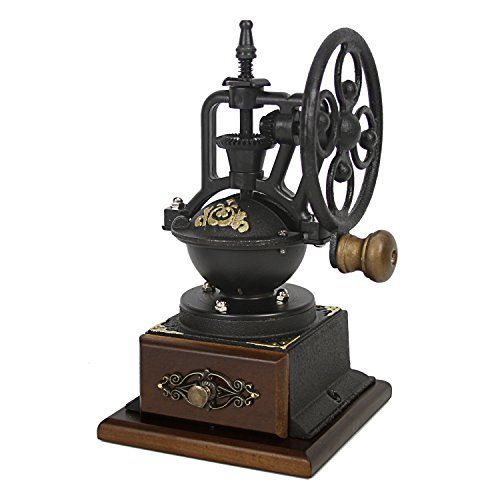 | 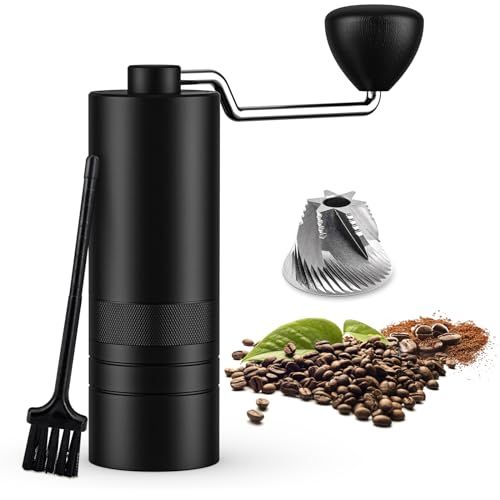 | 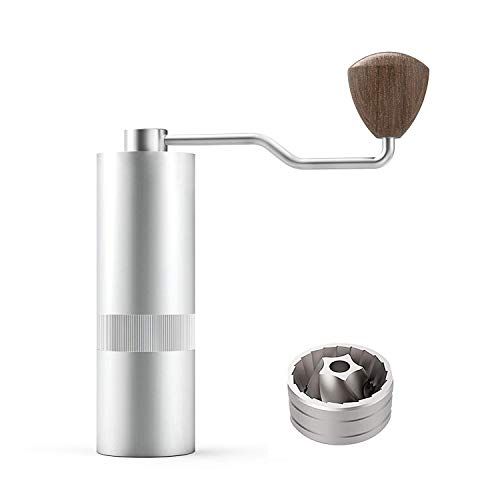 | 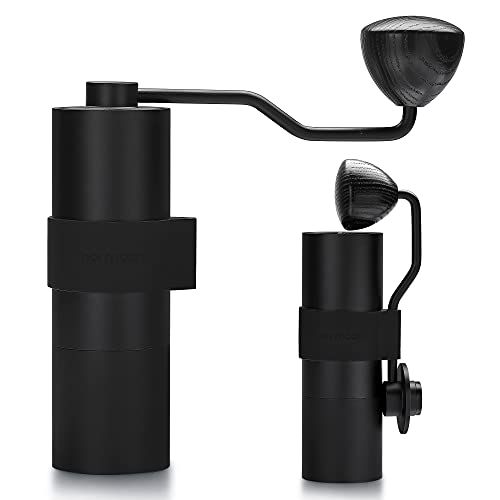 | 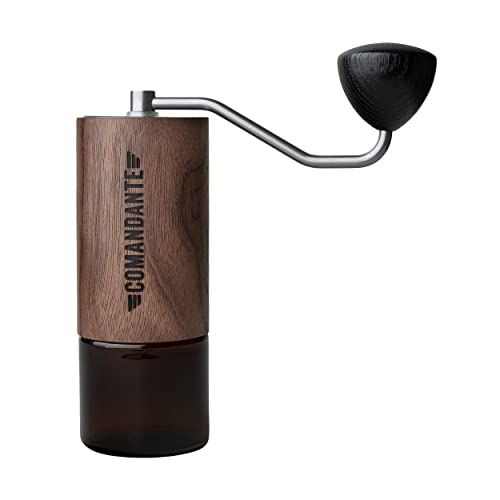 | |
|---|---|---|---|---|---|
| Model | Evelyne GMT-10012 | GERYLOVE XRT-MCG | JUNOESQUE JM38 | Normcore V2 | Comandante C40MK4VW |
| Brand | Evelyne | GERYLOVE | JUNOESQUE | Normcore | Comandante |
| Model Number | GMT-10012 | XRT-MCG | JM38 | V2 - 38mm Stainless Steel Burr | C40MK4VW |
| Material | Cast Iron, Ceramic | Aluminium | Stainless Steel, Ceramic, Aluminium | Aluminium | Stainless Steel |
| Item Weight | 1.68 kg | 450 g | 689 g | 408 g | 1.1 kg |
| Colour | Black | Black | Silver | Black | Brown |
| Specific Uses for Product | - | - | Coffee Grinder | - | - |
| Recommended Uses for Product | Grinding | - | Grinding | Grinding | Grinding |
| Price | - | £30.3 | £50.84 | £77.72 | £251.53 |
FAQ
What is a coffee grinder manual?
A coffee grinder manual is a guide or instruction booklet that provides information on how to operate, maintain and troubleshoot a coffee grinder. It explains the different parts and functions, and provides tips on usage, cleaning, and repairs. The manual aims to help owners understand their grinder and optimise its performance.
Why is it important to read the manual before using a new coffee grinder?
Reading the manual first ensures you properly assemble, operate and care for the grinder. It provides safety warnings, troubleshooting advice, maintenance tips, and instructions on features. This helps prevent accidents, damage or improper use. Thoroughly reading and following the manual allows you to get the most out of your new coffee grinder.
Where can I find the manual for my coffee grinder?
The manual is usually included in the original packaging. Many brands also provide digital copies on their websites that can be downloaded. If you have lost the manual, check the manufacturer's website or contact their customer service. You can also find some manuals by searching online.
What kind of information is typically included in a coffee grinder manual?
Typical contents include: set-up/assembly instructions, operating procedures, cleaning and maintenance guidelines, troubleshooting tips, product specifications, warranty details, safety warnings, contact information for the manufacturer, and diagrams of parts.
My manual is missing pages. Where can I find a complete version?
First, check the manufacturer's website - they often have digital copies available to download. If not, contact the manufacturer's customer service department directly to inquire about obtaining a full manual. As a last resort, generic manuals or copies may be available on third-party sites, but quality is not guaranteed.
I lost my manual. Can I order a replacement copy?
Most manufacturers can provide a replacement manual if contacted directly. Some may charge a small fee to cover printing and shipping. Check their website or customer service contacts to inquire about getting a new copy of the instructions. Providing your product's model number helps them send the correct version.
The print in my manual is too small for me to read comfortably. Is there an option for larger text?
Some brands provide digital copies of manuals on their websites that can be enlarged or printed in a larger font size. Contact the manufacturer to see if a large print version is available. If not, third party sites may have user manuals available which are more readable. Magnifying glasses or apps can also help enlarge print material.
Can I get the coffee grinder manual in a different language?
Manuals are typically available in the languages relevant to the country where the product is sold. To get one in an alternate language, contact the manufacturer's customer service. If available, they can provide or direct you to a translated version. Some user manuals on third party sites also exist in other languages.
The instructions in my manual aren't clear. Is there a resource to help decipher them?
Contacting the manufacturer's customer service is the best option for help understanding unclear instructions in your coffee grinder's manual. They can provide guidance, direction to supplemental resources, or connect you with service technicians if needed. Online user forums related to that specific grinder can also help clarify ambiguities.
I tried following my manual but I'm still having issues operating my coffee grinder. What should I do?
First, carefully re-read the sections relevant to the problem. If still unable to resolve it, contact the manufacturer's customer service. They can offer troubleshooting tips or set up a warranty repair if needed. Be prepared to describe the issue in detail. The manual itself may also have contact info for repairs or service.
